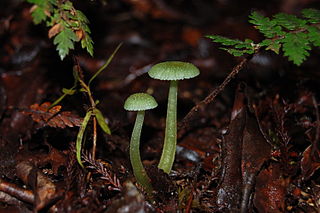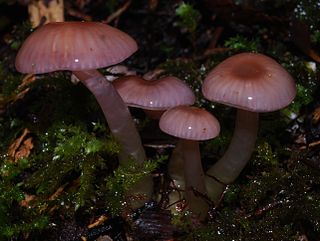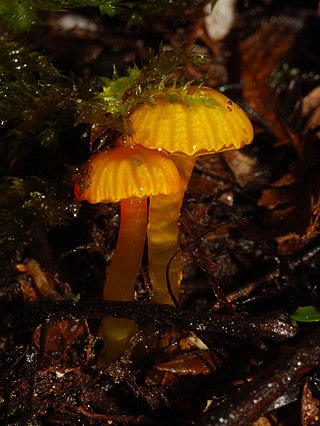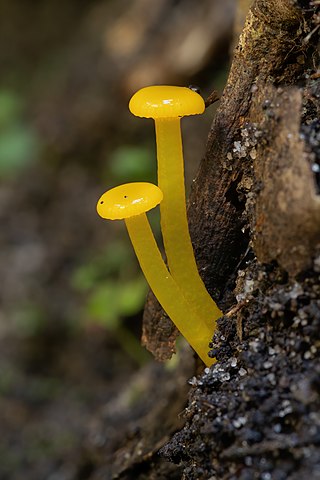
Amanita porphyria, also known as the grey veiled amanita or the porphyry amanita, is a fairly common, inedible mushroom of the genus Amanita found in Europe and North America.
Index Fungorum is an international project to index all formal names in the fungus kingdom. As of 2015 the project is based at the Royal Botanic Gardens, Kew, one of three partners along with Landcare Research and the Institute of Microbiology, Chinese Academy of Sciences.

Gliophorus psittacinus, commonly known as the parrot toadstool or parrot waxcap, is a colourful member of the genus Gliophorus, found across Northern Europe. It was formerly known as Hygrocybe psittacina, but a molecular phylogenetics study found it to belong in the genus Gliophorus. It had already been placed in Gliophorus, but it had been considered a synonym of Hygrocybe.

Pier Andrea Saccardo was an Italian botanist and mycologist. He was also the author of a color classification system that he called Chromotaxia. He was elected to the Linnean Society in 1916 as a foreign member. His multi-volume Sylloge Fungorum was one of the first attempts to produce a comprehensive treatise on the fungi which made use of the spore-bearing structures for classification.

Agaricus silvaticus, otherwise known as the scaly wood mushroom, blushing wood mushroom, or pinewood mushroom, is a species of mushroom often found in groups in coniferous forests from early summer, or September through to November in Europe, North Africa and North America.

Carlo Luigi Spegazzini, in Spanish Carlos Luis Spegazzini, was an Italian-born Argentinian botanist and mycologist.

Gliophorus is a genus of agaric fungi in the family Hygrophoraceae. Gliophorus species belong to a group known as waxcaps in English, sometimes also waxy caps in North America or waxgills in New Zealand. In Europe, Gliophorus species are typical of waxcap grasslands, a declining habitat due to changing agricultural practices. As a result, two species, Gliophorus europerplexus and Gliophorus reginae, are of global conservation concern and are listed as "vulnerable" on the IUCN Red List of Threatened Species.

Amanita ananiceps is a species of agaric fungus in the family Amanitaceae native to Australia.

Gliophorus graminicolor is a species of agaric fungus in the family Hygrophoraceae. It is found in Australia and New Zealand. In 1995, Australian mycologists Tom May and Alec Wood transferred the species to Hygrocybe, but the taxonomic authority Index Fungorum retains it in Gliophorus.

Gliophorus versicolor is a species of agaric fungus in the family Hygrophoraceae. Found in New Zealand, it was described as new to science in 1973 by mycologist Egon Horak. Within the genus Gliophorus, it is classified in the section Glutinosae, a grouping of species characterized by having bright colors, decurrent gills, and a gelatinized subhymenium. Fruit bodies have hemispherical to convex caps typically measuring 20 mm (0.8 in), although some have been recorded up to 50 mm (2.0 in). Moist caps are gluey with a color ranging from reddish brown to pinkish-lilac; the cap margin has radial grooves mirroring the gills underneath. The gills have an adnate to somewhat decurrent attachment to the stipe. They are widely spaced with color similar to the cap, or whitish. The cylindrical, hollow stipe measures 2–7 cm (0.8–2.8 in) by 1.5–3 mm (0.06–0.12 in) thick. The fungus is saprobic, and fruits on the ground among Dacrycarpus and Nothofagus.

Gliophorus lilacipes is a species of agaric fungus in the family Hygrophoraceae. Found in New Zealand, it was described by Egon Horak in 1973.
Gliophorus bichromus is a species of agaric fungus in the family Hygrophoraceae. Found in New Zealand, it was described by mycologist Egon Horak in 1973.

Gliophorus laetus is a species of agaric fungus in the family Hygrophoraceae. Originally described as new to science by Christian Hendrik Persoon in 1800, it was transferred to the genus Gliophorus in 1958. It is considered edible, but of little interest.
Gliophorus pallidus is a species of agaric fungus in the family Hygrophoraceae. Found in New Zealand, it was described as new to science in 1973.

Gliophorus reginae is a species of agaric in the family Hygrophoraceae. It has been given the recommended English name of jubilee waxcap. The species has a European distribution, occurring mainly in agriculturally unimproved grassland. Threats to its habitat have resulted in the species being assessed as globally "vulnerable" on the IUCN Red List of Threatened Species.

Gliophorus viridis is a species of agaric fungus in the family Hygrophoraceae found in New Zealand and Australia.

Gliophorus viscaurantius is a species of agaric fungus in the family Hygrophoraceae found in New Zealand.

Gliophorus chromolimoneus is a species of agaric fungus in the family Hygrophoraceae found in New Zealand and Australia.
Amanita groenlandica is a species of fungus in the family Amanitaceae. It has been placed in Amanita sect. Vaginatae.














